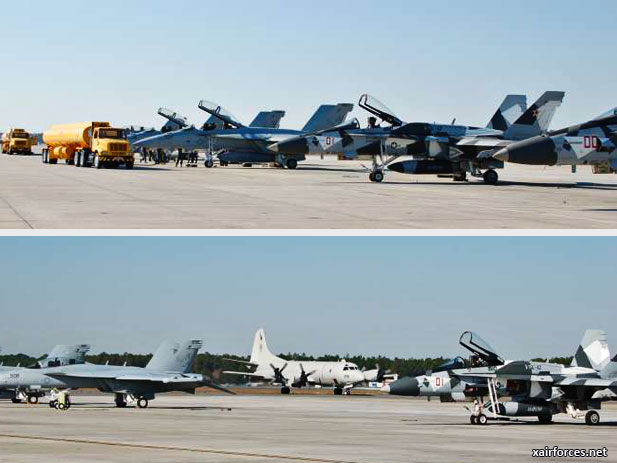
Special aircraft test defenses of carrier strike group

A six-plane detachment of F/A-18A+ Hornets from Fighter Squadron Composite (VFC) 12, along with a six-plane detachment operated by Airborne Tactical Advantage Company (ATAC), a two-plane detachment from L-3, and a two-plane detachment from Phoenix Air are operating from NAS Jacksonville to provide “adversary threat training” for the Harry S. Truman (CVN 75) Strike Group that is currently underway in the Atlantic for its Composite Training Unit Exercise (COMPTUEX)
Together, aircraft from VFC-12, plus contractor adversary support providers such as ATAC, L-3 and Phoenix Air represent a formidable and realistic hostile opposing force to sharpen the war fighting capabilities of Navy expeditionary forces preparing for deployment.
Cmdr. Jeff Menna, a pilot with VFC-12, explained that the “Fighting Omars” are the Naval Reserves’ premier adversary squadron for providing threat tactics training to Navy strike fighter squadrons,
“Based at NAS Oceana in Virginia Beach, our main job is to provide tactical ‘dissimilar air combat training’ for Navy, Marine Corps and other aviation units when tasked. For COMPTUEX, we primarily oppose air strikes from the carrier air wing as they enter or leave the air space of Pinecastle Range Complex,” said Menna. “Our goal is to enable strike fighter aircrew to hone their war fighting skills against a creditable adversary prior to deploying in the face of real threats.”
In late 2012, VFC-12 began their transition from the blue camouflage F/A-18C Hornet that they flew for seven years – to the upgraded F/A-18A+ Hornet painted in the bold SU-35 Flanker Arctic Splinter camouflage.
The unique challenges inherent to the squadron’s mission make the Fighting Omars one of the Navy’s most sought after aviation duty assignments in the Navy. Although highly skilled and qualified in the art of aerial combat, all newly assigned pilots must complete a thorough and unique flight syllabus. Among the squadron’s most frequent deployment sites are NAS Jax, NAS Key West and NAS Fallon, Nev.
ATAC pilot Rob DeStasio said, “According to daily tasking from Commander, Strike Force Training Atlantic (CSFTA), ATAC aircraft present a variety of threat profiles – either against Carrier Air Wing-3, surface ships in the strike group, or both.
“We may also fly joint missions against the strike group with Hornets from VFC-12 or Lear jets from L-3,” said DeStasio.
“L-3 has provided the Navy with COMPTUEX adversary support for a number of years,” explained Jim Bailey. “Our Lear jets deliver threat simulations for ship attacks, as well as towing aerial targets for ships and fighter aircraft. Depending on the training requirements of CSFTA, we may also fly joint missions with ATAC and other threat providers.”
COMPTUEX is a series of training scenarios designed to certify Harry S. Truman (CVN 75) Strike Group as a deployment-ready fighting force capable of completing operations in overseas theaters.
Source: USS Harry S. Truman Strike Group COMPTUEX (Jacksonville.com) News - By Clark Pierce
Editor - 30 January 2013
Photo: The U.S. NAS F/A-18A Hornets and E/A-18G Growlers (Photo by Clark Pierce)
JP-5 trucks pull up on the NAS Jax flight line Jan. 23 as VFC-12 maintainers prepare their F/A-18A+ aircraft for air-to-air combat against against Carrier Air Wing 3 aircraft embarked with the Harry S. Truman (CVN 65) Strike Group.
A P-3C Orion based at NAS Jax (center) taxis behind E/A-18G Growlers (left) based at NAS Whidbey Island, Wash., and F/A-18A+ Hornets based at NAS Oceana, Va.
(30.01.2013)
|